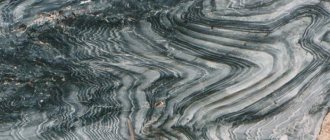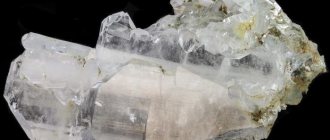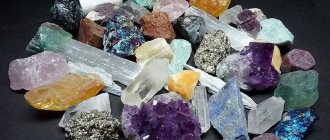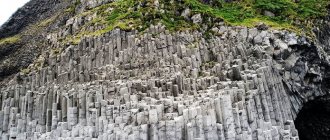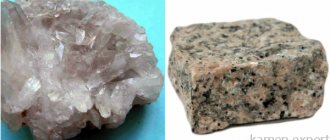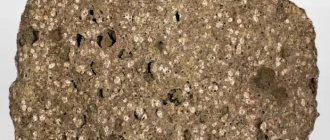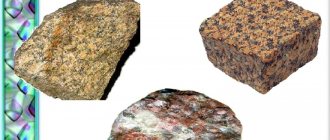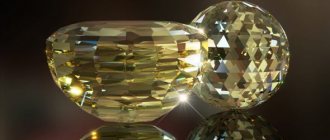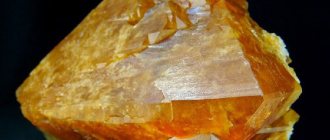- Reports
- Geography
- Rocks
On our planet, in the bowels of the earth there is a huge amount of fossils, they are usually called rocks. Basically, rocks are made up of a collection of minerals that are found in the earth's crust.
Rocks include not only solids, but also water, natural gas and oil.
The term “rocks” was introduced in 1798 by geologist V.M. Severgin. This term summarized all the sciences known at that time for the study of the earth’s crust and the rocks that are in it.
Rocks are often classified by composition:
- Sour
- Basic
- Alkaline
There are three classes of rocks.
Igneous rocks
The name comes from the fact that this class of rocks is formed from magma. Such rocks are usually very hard and are found deep in the earth, where high temperatures prevail.
This class of rocks includes granite, which makes up the largest percentage of rocks found on Earth.
Granite is not formed in its pure form; it contains a lot of non-ferrous and precious metals.
If magma solidifies in the depths of the earth, then the rock is formed with large crystals, but if it pours out and solidifies on the surface, then this rock has a fine crystalline structure.
Main Differences
It is not always clear to people who do not understand geology how rocks differ from minerals. Although both groups of materials are naturally occurring compounds, there are differences between them. Both minerals and rocks are part of the earth's crust and are of great interest to science.
Minerals are native, stable chemical elements with unique properties. They are formed as a result of complex natural processes. But today people have learned to grow them themselves in laboratories, marine factories and farms. Rocks are composed of one or more minerals. That is why they may have the same names, but one rock may contain a variety of minerals.
The main difference between the two concepts is heterogeneity. If minerals are built on the basis of a crystal lattice, then rocks consist of microparticles that are connected in a chaotic manner. That is, such material does not have a single structure.
The earth's crust is made up of many minerals and rocks. They have different origins, physical and chemical properties. And man has long learned not only to extract and use them in various fields, but also to grow minerals on his own.
Sedimentary rocks
This type of rock is formed mainly on the surface of the earth. Formation occurs when sediments collect at the bottom of a reservoir or on land, under the influence of gravity.
Sedimentary rocks are divided into three subtypes:
Chemical
Such rocks are formed mainly at the bottom of a reservoir with potassium and salt. These rocks are called potassium salts, which we often use in industry.
Organic (organogenic)
This subspecies of rocks is formed from the remains of plants and animals at the bottom of the reservoir. Such sediments can accumulate for millions of years before forming rock. Organic sedimentary rocks make up 70% of the earth's surface. These include limestones, combustible rocks and phosphorites.
Clastic
Such rocks got their name due to the fact that they are formed from fragments of various rocks. Basically, such rocks are formed from fine crushing of rocks; they are often used in industry, or more precisely in construction. Such rocks usually include sand, crushed stone, pebbles and clay.
Origin of minerals
Minerals are homogeneous natural bodies that are chemical compounds of a certain composition. They have a crystalline structure, were formed as a result of geological processes and are considered components of rocks. There are three versions of the origin of minerals:
- magmatic;
- metamorphic;
- exogenous.
Solid materials can form due to the solidification and crystallization of magma. This alloy includes silicates, as well as almost all chemical elements. Some volatile substances get into the cracks of crystallizing rocks. They transform them, so different types of ores are formed: tungsten, tin, molybdenum. And when the temperature drops, deposits of copper, gold, lead, zinc, silver and tin are formed.
During metamorphic processes, minerals are formed under the influence of temperature and pressure. This phenomenon is associated with a change in the biological situation. During regional metamorphism, significant areas at depth are affected. And as a result of the contact process, magma affects the thickness of limestone.
Exogenous processes are based on solar energy. They occur at low temperatures and normal pressure near the earth's surface. At the same time, rocks exposed or lying at shallow depths are weathered, washed away by water and destroyed by living organisms.
Accepted classification
Geologists are still studying some minerals and figuring out what they are. Based on their work, several types of solid materials can be distinguished. They are divided according to their structure and chemical properties:
- silicates;
- carbonates;
- oxides and hydroxides;
- sulfides and sulfates;
- halides;
- phosphates;
- tungstates;
- native elements.
The class of silicates includes salts of silicic acids. They are part of any rock. It is the most abundant type of mineral on Earth. Carbonates are salts of carbonic acid. The most famous of them: calcide, magnesite, dolomite. Oxides and hydroxides are so called because of their chemical structure. These minerals are compounds of hydroxyl groups and oxygen. These include quartz and hematite.
Sulfides contain sulfur , and sulfates contain salts and its acids. The first group includes pyrite and cinnabar, and the second group includes gypsum and anhydride. Halides and phosphates are salts of halide and phosphoric acid, respectively. The first class includes sylvite and fluorite, and the second class includes apatite and phosphorite. Tungstates are salts of tungstic acid. The definition of native elements is also related to their properties. These are minerals that include only one component: gold, diamond, sulfur.
Basic properties
All minerals have their own chemical and physical properties. This is worth talking about in a report about rocks and their elements. Physical properties include fragility, causticity, brittleness and flexibility. One of the most important indicators for minerals is hardness. Talc is considered the softest, and diamond is the most durable.
These properties of minerals also include cleavage, fracture and tarnish. The first concept means the ability of a material to split along the crystalline direction. Tarnish is the presence of a thin colored film on the surface; it is formed through oxidation. And fractures are formed upon impact.
Minerals also have optical properties:
- color;
- shade of a trait;
- magnetic properties.
For some materials the color may be uniform, for others it is variable. Some minerals undergo many modifications. That is, they contain impurities, or they change color depending on the lighting. The color of the streak appears when scratched. This is exactly the shade the mineral takes on when it is ground into powder. Reflectivity is the shine that a luminous flux creates. Expensive varieties of minerals sparkle under the sun's rays. Materials that contain divalent iron have magnetic properties.
Areas of use
Today man has learned to use more than 15% of known minerals. They are mainly used in industry. The area of their use most often depends on the physical properties:
- abrasive and anti-abrasive materials are made from hard materials;
- quartz is necessary for the radio-electronic industry;
- Mica has been shown to have electrical insulating properties.
Talc is used in medicine and lubricants are made from it. Asbestos mixtures have long been used in construction; they are a good heat insulator. And fluorite, due to its properties, is used in optics. All minerals are divided into ore and non-ore. From the former, metal elements can be extracted, and from the latter, non-metallic raw materials for medicine, chemistry or construction.
Stones are also used in jewelry. In this case, they are divided by value. The most expensive jewelry is considered to be diamond, pearl, pyrite. And the cheapest ones are onyx, obsidian, alabaster. The latter are also called ornamental.
What is marble
Marble is a dense crystalline rock composed of calcite or a mixture of calcite and magnesium compounds. Marble products are well polished, as the stone is quite soft.
On a fresh chip, large calcite crystals will shine, while aggregates of small crystals will look dull.
The color depends on the composition of impurities, which change the color of the stone and create banding, spotting, and “cloudyness.”
Marble has a property that is important to its definition. When dilute hydrochloric acid gets on the surface of the stone, a chemical reaction begins with the release of gas, abundant foam and hissing appear. If there is a lot of magnesium in the marble, the reaction is less active.
Chemical composition
Silvin is the most important component of potassium salt. It makes up 52.44% of the substance. Other substances: carnallite (35.8%), kainite (14.07%), polyhalite (12.97%), langbeinite (18.84%); others - leonite (21.32%), shenite (19.41%); snngenit (23.81%). Main potassium rocks
: carnallite - 45-85% carnallite and 18-50% halite with a low content of sylvite, anhydrite, clay minerals and carbonates; sylvinite - 95-98% sylvin and halite, the rest is an insoluble residue (in the best varieties 0.5-2.0%, sometimes contains significant amounts of polyhalite or langbeinite and rarely borates); hartzaltz (solid salt) - 8-25% sylvite, 18-30% kieserite, 40-60% halite.
Option No. 2
Rocks are compounds of natural origin that form the basis of the earth's crust. They consist of various minerals connected to each other by a strong (hard rock) or weak (loose rock) bond. Such compounds are formed during ongoing underground or surface tectonic processes.
Rocks differ in their friability, structural and textural characteristics.
The looseness of the rock determines the location of its occurrence. Thus, plains are composed primarily of loose rocks: sand, clay, gravel, etc. Mountains, on the contrary, are largely composed of hard rocks. These are mineral deposits, for example, ores of ferrous and non-ferrous metals, shale, etc.
The structure of a rock is the type of composition of minerals. There are four types of structure:
1) coarse-grained;
2) fine-crystalline;
3) glassy;
4) combined type, combining different structures.
Texture refers to the position and distribution of mineral grains in a rock relative to each other. The following groups of structures are distinguished:
1) massive, when the placement of minerals is random;
2) shale, consisting of flat minerals that are stretched in one direction;
3) layered, consisting of layers with different mineral compositions;
4) bubbly, with voids - traces of gas release;
5) porous, when the rock is penetrated by many pores.
The most common classification of rocks is the classification according to the type of their formation. It is customary to distinguish igneous, sedimentary and metamorphic rocks.
Igneous rocks are formed by the solidification of molten igneous mass. These rocks include granite, basalt, and pumice (with a porous structure). Igneous rocks are usually hard, granular, composed of small mineral crystals, and heavy.
Sedimentary rocks are created exclusively above the surface of the earth under the influence of natural elements. They are divided into three groups:
1) clastic - rocks formed as a result of the crumbling of other rocks into fragments, under the influence of wind, accumulation of fragments and their movement (clay, sand, crushed stone);
2) chemical - rocks formed from the combination of fine mineral dust with other substances (potassium salt, silica);
3) organic - rocks consisting of the remains of flora and fauna, accumulating at the bottom of reservoirs over millions of years (coal, oil, chalk, limestone).
Sedimentary rocks are characterized by a porous or layered texture.
Metamorphic rocks are initially formed as igneous or sedimentary rocks, and then change under the influence of pressure, temperature, and geological processes. Thus, limestone can transform into marble, and sandstone can transform into quartzite.
Thus, the layers of the earth's crust are entirely composed of various rocks of igneous, sedimentary and metamorphic origin. They are deposits of minerals, which are widely used in human economic and industrial activities.
3, 4 world around, 5 in geography, 6th grade
Types of Marble
Various impurities change the color of marble. Experts distinguish types of rock based on its origin and color. There are Bavarian red, Carrara snow-white (Italy), French pink and other marbles. At the beginning of the 18th century, statues decorating the Summer Garden of St. Petersburg were created from Carrara marble.
Rice. 3. Sculptures in the Summer Garden.
You can prepare a report for a lesson on the surrounding world in 2nd grade about what rocks marble belongs to.
Stones and slabs
Wall stones
obtained from tuffs and porous limestones by mechanized sawing from a rock mass or sawing blank blocks. Stones are used for laying external and internal walls and partitions.
Main dimensions of wall stones: 390x190x188; 490x240x188;
390x190x288 mm. Each such stone replaces 8-12 bricks in a masonry. It is advisable to produce and use wall blocks
volume of at least 0.1 m3 made of tuff, limestone, dolomite, sandstone or porous andesite (Fig. 3). Enlargement of stones reduces labor costs and allows the transition to industrial construction methods. Walls made of finely porous natural stone do not require external plaster or cladding.
Fig.3. Blocks:
a) chopped; b) hewn; c) sawn
For external walls, stones with a density of no more than 2300 kg/m3 are used. The water absorption of the stone should be no more than 30%, frost resistance - no less than 15.
slabs are used for cladding hydraulic structures, embankments, bridge abutments, and the basement of monumental buildings.
from granite and other igneous rocks, which are characterized by high frost resistance, strength and hardness. Stones for facing can be slab-shaped (15-25 cm thick), thickened pyramidal (30 cm thick or more).
External cladding
buildings can be made from weather-resistant sedimentary rocks (limestones, dolomites, sandstones, tuffs), which are easier to process and more economical than granite rocks. For the internal cladding of public buildings and structures (for example, metro stations), slabs made from easily sawn rocks: marble, anhydrite, and gypsum are widely used.
Slabs for external cladding have a thickness of 4-8 cm, for internal cladding - 1.2-4 cm. The use of diamond cutters makes it possible to produce thin (5-10 mm) economical slabs, the cost of which is 2-4 times lower than conventional ones. Thin slabs are widely used, especially for interior cladding.
Special claddings
used for protection against corrosion and high temperatures. To protect against acid solutions (except hydrofluoric and hydrofluorosilicic), andesite, granite, syenite, diabase, quartzite, siliceous sandstone and other acid-resistant rocks are used.
Base slabs,
as well as parts of cornices, belts and other protruding parts of structures are made from resistant rocks. These products should not have hairline cracks; they should be shaped in such a way that water from rain and melting snow does not linger on them.
Slabs for floors and stone steps
internal stairs must have high wear resistance and decorative properties that correspond to the interior architecture.
Natural stone materials are used in large quantities for hydraulic engineering
structures. In a zone of variable water levels, the service conditions of the material are especially unfavorable: the stone experiences repeated freezing and thawing in a water-saturated state. The protective lining in this zone is made of dense igneous rocks with a water absorption of no more than 1%, a strength grade of at least 80-100 MPa and frost resistance of 150-500, depending on the class of the structure, climatic and other operating conditions. Materials for rockfill dams must also meet the relevant requirements. The internal parts of the outline can be made from stone obtained from sedimentary rocks of grades 30-60 MPa with a softening coefficient of at least 0.7-0.8. Stone materials are tested for the influence of substances dissolved in water (sea, ground, river, swamp).
side stones,
separating the roadway from the sidewalk, are made of dense igneous rocks (granite, diabase, etc.), characterized by high frost and wear resistance and strength. Side stones are straight and curved, high - up to 40 cm and low - up to 30 cm. These stones are used instead of concrete ones with appropriate technical and economic
justification.
Paving stones
for paving roads, it has the shape of a block, slightly tapering downward. Paving stones are made using a mechanized method from homogeneous fine- and medium-grained rocks (diabase, etc.). From such rocks a block for mosaic pavement (close in shape to a cube) and a block for paving (in the form of a truncated pyramid) are made.
Paving slabs
made from gneisses and similar layered rocks. They have the shape of a rectangular or square slab with a side of 20-80 cm with a flat surface, a thickness of at least 4 cm and no more than 15 cm.
Acid-resistant stone products
Some igneous and metamorphic (quartzite) rocks are used for lining various installations and apparatuses exposed to acids, alkalis, salts and aggressive gases, as well as those exposed to high and sharply changing temperatures and pressures. Acid-resistant rocks are used for the production of hewn slabs, bricks, bars and shaped products, and in crushed and ground form they serve as aggregates and fillers in acid-resistant concrete, and are components of acid-resistant cements.
In accordance with the intended purpose, the rocks used must meet certain requirements, namely:
be acid-resistant, i.e. good resistance to various acids and other reagents; this property is assessed by the solubility of the rock powder in concentrated acids (hydrochloric, sulfuric) when heated; have high fire resistance: have sufficient resistance to compression and bending, as well as viscosity; withstand sudden temperature fluctuations.
Of the igneous rocks, acid-resistant are mainly acidic fine-crystalline rocks, which include beshtaunite, andesites, granites and some tuffs, and of metamorphic rocks - quartzites.
The use of acid-resistant piece stone is limited by its high cost, due to the difficulty of mining and processing, as well as the low yield of finished products from the rock mass. A complete substitute for stone is much cheaper acid-resistant concrete. Artificial cast stone (basalt, diabase) also competes with piece cut stone.
